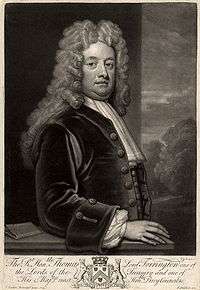Thomas Newport, 1st Baron Torrington

Thomas Newport, 1st Baron Torrington PC (c. 1655 – 27 May 1719),[1] styled The Honourable from 1675 until 1716, was an English peer, barrister and Whig politician.
Background
Born in High Ercall, he was the fifth and second surviving son of Francis Newport, 1st Earl of Bradford and his wife Lady Diana Russell, daughter of Francis Russell, 4th Earl of Bedford.[2] Newport was educated at Christ Church, Oxford and matriculated in 1672.[3] He was called to the Bar by the Inner Temple in 1678 and became a reader in 1700.[3]
Career
In 1695, he entered the English House of Commons, representing Ludlow until 1698 as well as between 1699 and the following year.[4] Newport sat further for Winchelsea from January to November 1701.[5] In 1715, he was elected to the British House of Commons for (Much) Wenlock, a seat he held until 1716,[6] when he was elevated to the Peerage of Great Britain as Baron Torrington, of Torrington, in the County of Devon.[7]
Between 1699 and 1712, Newport was a Commissioner of Customs.[8] In 1715, he was appointed a Lord of the Treasury and held this office until 1718.[8] Subsequently he served as one of the four Teller of the Exchequer until his death in 1719.[8] In 1717, Newport was sworn of the Privy Council of Great Britain.[9]
Family
Newport married firstly Lucy Atkyns, daughter of Sir Edward Atkyns.[3] After her death in 1696, he married Penelope Mary Bridgeman, daughter of Sir Orlando Bridgeman, 1st Baronet in Chelsea, London on 22 July 1700.[3] She died only five years later and Newport married thirdly Anne Pierrepont, daughter of Robert Pierrepont on 8 July 1709.[3]
He died childless and was buried in Wroxeter.[10] His barony became extinct.[2]
References
- ↑ "Leigh Rayment - Peerage". Retrieved 1 July 2009.
- 1 2 Burke, John (1831). A Genealogical and Heraldic History of the Peerages of England, Ireland, and Scotland. London: Henry Colburn and Richard Bentley. p. 396.
- 1 2 3 4 5 Eveline Cruickshanks, Stuart Handley and D. W. Hayton, ed. (2002). The House of Commons, 1690-1715. vol. IV. Cambridge: Cambridge University Press. pp. 1024–1025.
- ↑ "Leigh Rayment - British House of Commons, Ludlow". Retrieved 1 July 2009.
- ↑ "Leigh Rayment - British House of Commons, Winchelsea". Retrieved 1 July 2009.
- ↑ "Leigh Rayment - British House of Commons, (Much) Wenlock". Retrieved 1 July 2009.
- ↑ The London Gazette: no. 5445. p. 2. 23 June 1716. Retrieved 1 July 2009.
- 1 2 3 Haydn, Joseph (1851). The Book of Dignities: Containing Rolls of the Official Personages of the British Empire. London: Longman, Brown, Green and Longman's. pp. 111, 234, 498.
- ↑ "Leigh Rayment - Privy Council of Great Britain". Retrieved 1 July 2009.
- ↑ "ThePeerage - Thomas Newport, 1st and last Baron Torrington". Retrieved 20 November 2006.
| Parliament of England | ||
|---|---|---|
| Preceded by Silius Titus Francis Lloyd |
Member of Parliament for Ludlow 1695 – 1698 With: Charles Baldwyn |
Succeeded by Francis Herbert William Gower |
| Preceded by Francis Herbert William Gower |
Member of Parliament for Ludlow 1699 – 1700 With: Francis Herbert |
Succeeded by Sir Thomas Powys William Gower |
| Preceded by John Hayes Robert Bristow |
Member of Parliament for Winchelsea Jan – Nov 1701 With: Robert Bristow |
Succeeded by John Hayes Robert Austen |
| Parliament of Great Britain | ||
| Preceded by Sir William Forester Richard Newport |
Member of Parliament for (Much) Wenlock 1715 – 1716 With: William Forester |
Succeeded by William Forester Sir Humphrey Briggs |
| Political offices | ||
| Preceded by The Lord Onslow |
Teller of the Exchequer 1718–1719 |
Succeeded by Viscount Parker |
| Peerage of Great Britain | ||
| New creation | Baron Torrington 1716 – 1719 |
Extinct |